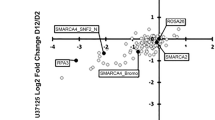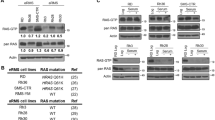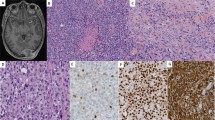Abstract
Rhabdomyosarcoma (RMS) is the most common soft tissue sarcoma in children and comprises two major histological subtypes: alveolar rhabdomyosarcoma (ARMS) and embryonal rhabdomyosarcoma (ERMS). Seventy-five percent of ARMS harbor reciprocal chromosomal translocations leading to fusion genes of the forkhead transcription factor FOXO1 and PAX3 or PAX7. The hedgehog (Hh) pathway has been implied in tumor formation and progression of various cancers including RMS. However, whether Hh pathway activation presents a general feature of RMS or whether it is restricted to specific subgroups has not yet been addressed. Here, we report that marker genes of active Hh signaling, that is, Patched1 (Ptch1), Gli1, Gli3 and Myf5, are expressed at significantly higher levels in ERMS and fusion gene-negative ARMS compared with fusion gene-positive ARMS in two distinct cohorts of RMS patients. Consistently, Gli1 expression correlates with Ptch1 expression in ERMS and fusion gene-negative ARMS, but not in fusion gene-positive ARMS. In addition, expression levels of MyoD1 are significantly lower in ERMS and fusion gene-negative ARMS, pointing to an inverse association of Hh activation and early muscle differentiation. Moreover, Myf5 is identified as a novel excellent class predictor for RMS by receiver operating characteristic analysis. Importantly, high expression of Ptch1 or low MyoD1 expression significantly correlate with reduced cumulative survival in fusion gene-negative RMS underscoring the clinical relevance of these findings. By showing that Hh signaling is preferentially activated in specific subgroups of RMS, our study has important implications for molecular targeted therapies, such as small molecule Hh inhibitors, in RMS.
This is a preview of subscription content, access via your institution
Access options
Subscribe to this journal
Receive 50 print issues and online access
$259.00 per year
only $5.18 per issue
Buy this article
- Purchase on Springer Link
- Instant access to full article PDF
Prices may be subject to local taxes which are calculated during checkout



Similar content being viewed by others
References
Barr FG, Qualman SJ, Macris MH, Melnyk N, Lawlor ER, Strzelecki DM et al. (2002). Genetic heterogeneity in the alveolar rhabdomyosarcoma subset without typical gene fusions. Cancer Res 62: 4704–4710.
Berman DM, Karhadkar SS, Hallahan AR, Pritchard JI, Eberhart CG, Watkins DN et al. (2002). Medulloblastoma growth inhibition by hedgehog pathway blockade. Science 297: 1559–1561.
Berman DM, Karhadkar SS, Maitra A, Montes De Oca R, Gerstenblith MR, Briggs K et al. (2003). Widespread requirement for Hedgehog ligand stimulation in growth of digestive tract tumours. Nature 425: 846–851.
Bijlsma MF, Spek CA, Zivkovic D, van de Water S, Rezaee F, Peppelenbosch MP . (2006). Repression of smoothened by patched-dependent (pro-)vitamin D3 secretion. PLoS Biol 4: e232.
Dagher R, Helman L . (1999). Rhabdomyosarcoma: an overview. Oncologist 4: 34–44.
Dantonello TM, Int-Veen C, Harms D, Leuschner I, Schmidt BF, Herbst M et al. (2009). Cooperative trial CWS-91 for localized soft tissue sarcoma in children, adolescents, and young adults. J Clin Oncol 27: 1446–1455.
Davicioni E, Anderson MJ, Finckenstein FG, Lynch JC, Qualman SJ, Shimada H et al. (2009). Molecular classification of rhabdomyosarcoma—genotypic and phenotypic determinants of diagnosis: a report from the Children's Oncology Group. Am J Pathol 174: 550–564.
Davicioni E, Finckenstein FG, Shahbazian V, Buckley JD, Triche TJ, Anderson MJ . (2006). Identification of a PAX-FKHR gene expression signature that defines molecular classes and determines the prognosis of alveolar rhabdomyosarcomas. Cancer Res 66: 6936–6946.
Gerber AN, Wilson CW, Li YJ, Chuang PT . (2007). The hedgehog regulated oncogenes Gli1 and Gli2 block myoblast differentiation by inhibiting MyoD-mediated transcriptional activation. Oncogene 26: 1122–1136.
Gustafsson MK, Pan H, Pinney DF, Liu Y, Lewandowski A, Epstein DJ et al. (2002). Myf5 is a direct target of long-range Shh signaling and Gli regulation for muscle specification. Genes Dev 16: 114–126.
Hahn H, Wojnowski L, Zimmer AM, Hall J, Miller G, Zimmer A . (1998). Rhabdomyosarcomas and radiation hypersensitivity in a mouse model of Gorlin syndrome. Nat Med 4: 619–622.
Hayes-Jordan A, Andrassy R . (2009). Rhabdomyosarcoma in children. Curr Opin Pediatr 21: 373–378.
Hooper JE, Scott MP . (2005). Communicating with hedgehogs. Nat Rev Mol Cell Biol 6: 306–317.
Kappler R, Bauer R, Calzada-Wack J, Rosemann M, Hemmerlein B, Hahn H . (2004). Profiling the molecular difference between patched- and p53-dependent rhabdomyosarcoma. Oncogene 23: 8785–8795.
Karhadkar SS, Bova GS, Abdallah N, Dhara S, Gardner D, Maitra A et al. (2004). Hedgehog signalling in prostate regeneration, neoplasia and metastasis. Nature 431: 707–712.
Khatib ZA, Matsushime H, Valentine M, Shapiro DN, Sherr CJ, Look AT . (1993). Coamplification of the CDK4 gene with MDM2 and GLI in human sarcomas. Cancer Res 53: 5535–5541.
Koleva M, Kappler R, Vogler M, Herwig A, Fulda S, Hahn H . (2005). Pleiotropic effects of sonic hedgehog on muscle satellite cells. Cell Mol Life Sci 62: 1863–1870.
Langenau DM, Keefe MD, Storer NY, Guyon JR, Kutok JL, Le X et al. (2007). Effects of RAS on the genesis of embryonal rhabdomyosarcoma. Genes Dev 21: 1382–1395.
McDermott A, Gustafsson M, Elsam T, Hui CC, Emerson Jr CP, Borycki AG . (2005). Gli2 and Gli3 have redundant and context-dependent function in skeletal muscle formation. Development 132: 345–357.
Merlino G, Helman LJ . (1999). Rhabdomyosarcoma—working out the pathways. Oncogene 18: 5340–5348.
Missiaglia E, Selfe J, Hamdi M, Williamson D, Schaaf G, Fang C et al. (2009). Genomic imbalances in rhabdomyosarcoma cell lines affect expression of genes frequently altered in primary tumors: an approach to identify candidate genes involved in tumor development. Genes Chromosomes Cancer 48: 455–467.
Nicol K, Savell V, Moore J, Teot L, Spunt SL, Qualman S . (2007). Distinguishing undifferentiated embryonal sarcoma of the liver from biliary tract rhabdomyosarcoma: a Children's Oncology Group study. Pediatr Dev Pathol 10: 89–97.
Oue T, Yoneda A, Uehara S, Yamanaka H, Fukuzawa M . (2010). Increased expression of the hedgehog signaling pathway in pediatric solid malignancies. J Pediatr Surg 45: 387–392.
Pasca di Magliano M, Hebrok M . (2003). Hedgehog signalling in cancer formation and maintenance. Nat Rev Cancer 3: 903–911.
Ragazzini P, Gamberi G, Pazzaglia L, Serra M, Magagnoli G, Ponticelli F et al. (2004). Amplification of CDK4, MDM2, SAS and GLI genes in leiomyosarcoma, alveolar and embryonal rhabdomyosarcoma. Histol Histopathol 19: 401–411.
Roberts WM, Douglass EC, Peiper SC, Houghton PJ, Look AT . (1989). Amplification of the gli gene in childhood sarcomas. Cancer Res 49: 5407–5413.
Romer JT, Kimura H, Magdaleno S, Sasai K, Fuller C, Baines H et al. (2004). Suppression of the Shh pathway using a small molecule inhibitor eliminates medulloblastoma in Ptc1(+/−)p53(−/−) mice. Cancer Cell 6: 229–240.
Rubin LL, de Sauvage FJ . (2006). Targeting the Hedgehog pathway in cancer. Nat Rev Drug Discov 5: 1026–1033.
Rudin CM, Hann CL, Laterra J, Yauch RL, Callahan CA, Fu L et al. (2009). Treatment of medulloblastoma with hedgehog pathway inhibitor GDC-0449. N Engl J Med 361: 1173–1178.
Ruiz i Altaba A, Sanchez P, Dahmane N . (2002). Gli and hedgehog in cancer: tumours, embryos and stem cells. Nat Rev Cancer 2: 361–372.
Scales SJ, de Sauvage FJ . (2009). Mechanisms of Hedgehog pathway activation in cancer and implications for therapy. Trends Pharmacol Sci 30: 303–312.
Sorensen PH, Lynch JC, Qualman SJ, Tirabosco R, Lim JF, Maurer HM et al. (2002). PAX3-FKHR and PAX7-FKHR gene fusions are prognostic indicators in alveolar rhabdomyosarcoma: a report from the children's oncology group. J Clin Oncol 20: 2672–2679.
Thayer SP, di Magliano MP, Heiser PW, Nielsen CM, Roberts DJ, Lauwers GY et al. (2003). Hedgehog is an early and late mediator of pancreatic cancer tumorigenesis. Nature 425: 851–856.
Tomczak KK, Marinescu VD, Ramoni MF, Sanoudou D, Montanaro F, Han M et al. (2004). Expression profiling and identification of novel genes involved in myogenic differentiation. FASEB J 18: 403–405.
Tostar U, Malm CJ, Meis-Kindblom JM, Kindblom LG, Toftgard R, Unden AB . (2006). Deregulation of the hedgehog signalling pathway: a possible role for the PTCH and SUFU genes in human rhabdomyoma and rhabdomyosarcoma development. J Pathol 208: 17–25.
Von Hoff DD, LoRusso PM, Rudin CM, Reddy JC, Yauch RL, Tibes R et al. (2009). Inhibition of the hedgehog pathway in advanced basal-cell carcinoma. N Engl J Med 361: 1164–1172.
Wachtel M, Runge T, Leuschner I, Stegmaier S, Koscielniak E, Treuner J et al. (2006). Subtype and prognostic classification of rhabdomyosarcoma by immunohistochemistry. J Clin Oncol 24: 816–822.
Watkins DN, Berman DM, Burkholder SG, Wang B, Beachy PA, Baylin SB . (2003). Hedgehog signalling within airway epithelial progenitors and in small-cell lung cancer. Nature 422: 313–317.
Williamson D, Missiaglia E, de Reynies A, Pierron G, Thuille B, Palenzuela G et al. (2010). Fusion gene-negative alveolar rhabdomyosarcoma is clinically and molecularly indistinguishable from embryonal rhabdomyosarcoma. J Clin Oncol 28: 2151–2158.
Acknowledgements
This work has been supported by grants from the Deutsche Forschungsgemeinschaft, the Bundesministerium für Bildung und Forschung, the European Community (ApopTrain, APO-SYS) and IAP6/18 (to SF), and from the Wilhelm-Sander-Stiftung 2003.112.3 (to HH). We would like to thank the Chris Lucas Trust for their support (to EM) and the Children's Cancer and Leukemia Group for providing tumor material and clinical information. La Ligue Nationale Contre Le Cancer in collaboration with Olivier Delattre kindly supported the expression profiling of tumors.
Author information
Authors and Affiliations
Corresponding author
Ethics declarations
Competing interests
The authors declare no conflict of interest.
Additional information
Supplementary Information accompanies the paper on the Oncogene website
Rights and permissions
About this article
Cite this article
Zibat, A., Missiaglia, E., Rosenberger, A. et al. Activation of the hedgehog pathway confers a poor prognosis in embryonal and fusion gene-negative alveolar rhabdomyosarcoma. Oncogene 29, 6323–6330 (2010). https://doi.org/10.1038/onc.2010.368
Received:
Revised:
Accepted:
Published:
Issue Date:
DOI: https://doi.org/10.1038/onc.2010.368
Keywords
This article is cited by
-
Hedgehog pathway in sarcoma: from preclinical mechanism to clinical application
Journal of Cancer Research and Clinical Oncology (2023)
-
Novel animal model of soft tissue tumor due to aberrant hedgehog signaling activation in pericyte lineage
Cell and Tissue Research (2022)
-
Context-dependent modulation of aggressiveness of pediatric tumors by individual oncogenic RAS isoforms
Oncogene (2021)
-
Up-regulation of GLI1 in vincristine-resistant rhabdomyosarcoma and Ewing sarcoma
BMC Cancer (2020)
-
Co-inhibition of BET proteins and PI3Kα triggers mitochondrial apoptosis in rhabdomyosarcoma cells
Oncogene (2020)



